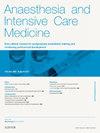Anaesthesia for vascular surgery on the extremities
IF 0.3
Q4 ANESTHESIOLOGY
引用次数: 0
Abstract
There are multiple types of procedure for vascular disease on the extremities, the majority of which are for the treatment of peripheral arterial disease (PAD). PAD is a common condition affecting 20% of people over the age of 60. Interventional treatment can be vascular, endovascular or combined (‘hybrid’) procedures by vascular surgeons and interventional radiologists.
PAD has risk factors in common with other atherosclerotic diseases which are often present, even if the patient is asymptomatic. Significant smoking histories are also common. Consequently, patients with PAD are a high-risk anaesthetic cohort. Comprehensive pre-operative assessment and investigation of the cardio-respiratory systems are essential to guide peri-operative planning. Multiple risk assessment tools are available to facilitate peri-operative decision making and risk-benefit discussions with patients.
The aim of intra-operative management is cardiovascular stability with proactive anticipation of events including haemorrhage and clamp release. Post-operatively regional anaesthesia is strongly advised particularly for patients undergoing amputation. Post-operative cardiac investigations may also be indicated.
Thoracic outlet syndrome and AV fistula formations are two specific clinical scenarios also covered in this topic.
四肢血管手术麻醉
对于四肢血管疾病有多种类型的手术,其中大多数是治疗外周动脉疾病(PAD)。PAD是一种常见疾病,影响了20%的60岁以上人群。介入治疗可以是血管、血管内或由血管外科医生和介入放射科医生联合进行的(“混合”)手术。PAD具有与其他动脉粥样硬化性疾病相同的危险因素,即使患者无症状。重要的吸烟史也很常见。因此,外周动脉患者是高危麻醉人群。全面的术前评估和心肺系统调查对指导围手术期计划至关重要。多种风险评估工具可用于促进围手术期决策和与患者进行风险-收益讨论。术中管理的目的是心血管稳定,积极预测出血和钳位释放等事件。强烈建议术后区域麻醉,特别是截肢患者。术后心脏检查也可能需要。胸廓出口综合征和房室瘘形成是两种特殊的临床情况也包括在这个主题。
本文章由计算机程序翻译,如有差异,请以英文原文为准。
求助全文
约1分钟内获得全文
求助全文
来源期刊

Anaesthesia and Intensive Care Medicine
ANESTHESIOLOGY-
CiteScore
0.50
自引率
0.00%
发文量
152
期刊介绍:
Anaesthesia and Intensive Care Medicine, an invaluable source of up-to-date information, with the curriculum of both the Primary and Final FRCA examinations covered over a three-year cycle. Published monthly this ever-updating text book will be an invaluable source for both trainee and experienced anaesthetists. The enthusiastic editorial board, under the guidance of two eminent and experienced series editors, ensures Anaesthesia and Intensive Care Medicine covers all the key topics in a comprehensive and authoritative manner. Articles now include learning objectives and eash issue features MCQs, facilitating self-directed learning and enabling readers at all levels to test their knowledge. Each issue is divided between basic scientific and clinical sections. The basic science articles include anatomy, physiology, pharmacology, physics and clinical measurement, while the clinical sections cover anaesthetic agents and techniques, assessment and perioperative management. Further sections cover audit, trials, statistics, ethical and legal medicine, and the management of acute and chronic pain.
 求助内容:
求助内容: 应助结果提醒方式:
应助结果提醒方式:


